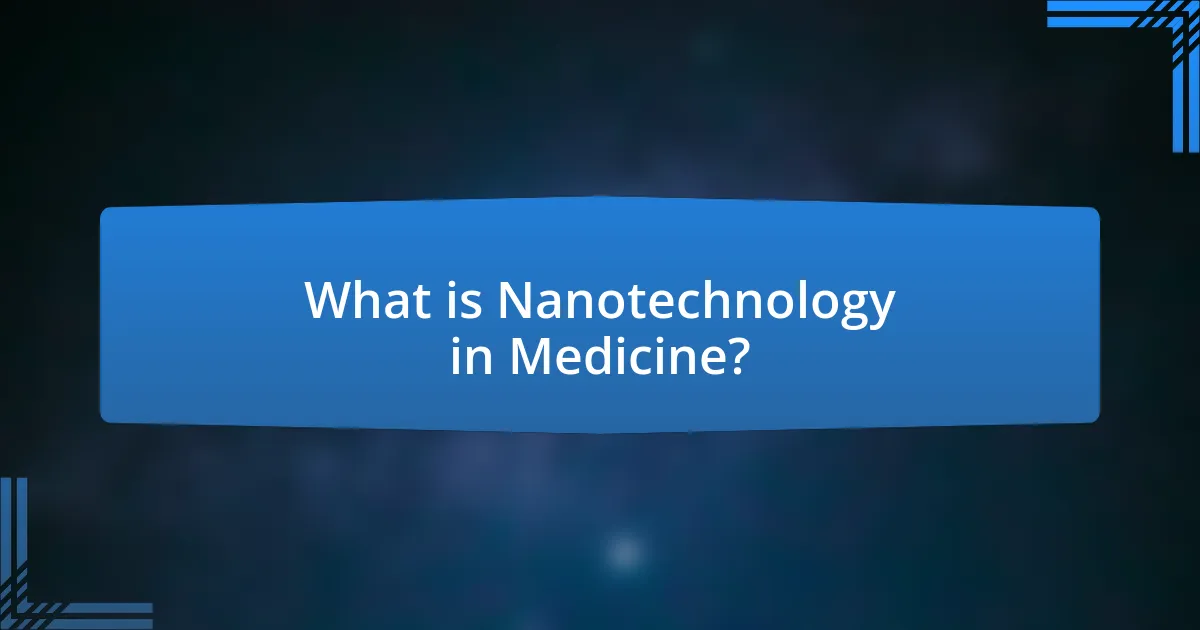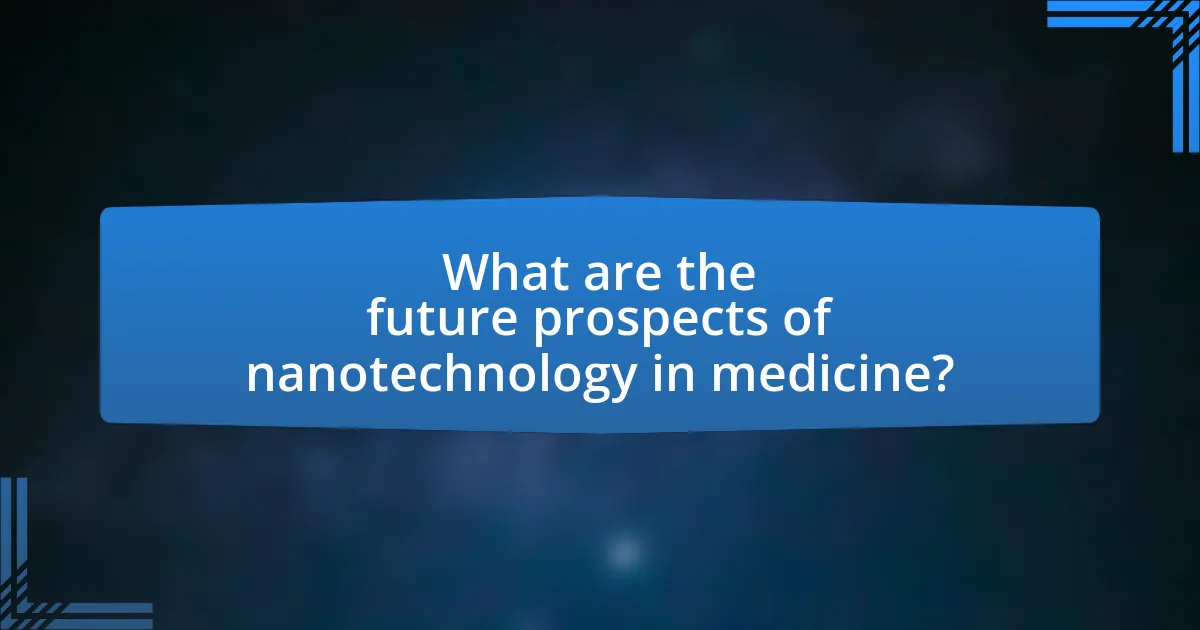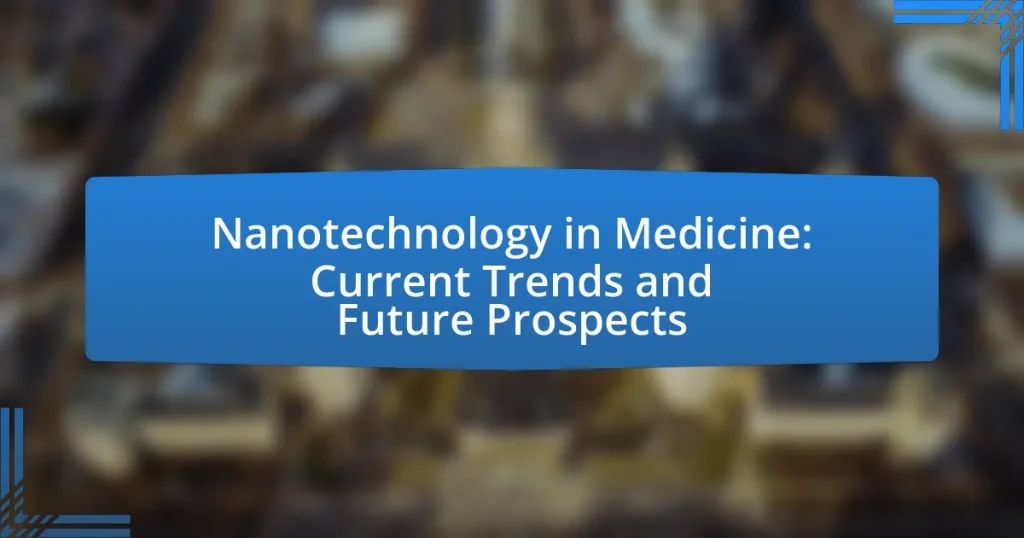Nanotechnology in medicine involves the application of nanoscale materials and devices for the diagnosis, treatment, and prevention of diseases at the molecular level. This article explores the integration of nanotechnology into medical practices, highlighting its key components such as nanoparticles, nanocarriers, and nanosensors, which enhance drug delivery, imaging techniques, and diagnostics. Current applications include targeted therapies for cancer, improved imaging methods, and advanced diagnostic tools, while future prospects focus on personalized medicine and regenerative therapies. The article also addresses challenges, ethical concerns, and the evolving regulatory landscape surrounding nanotechnology in healthcare.

What is Nanotechnology in Medicine?
Nanotechnology in medicine refers to the application of nanotechnology for the diagnosis, treatment, and prevention of diseases at the molecular and cellular levels. This field utilizes materials and devices at the nanoscale, typically between 1 to 100 nanometers, to enhance drug delivery, improve imaging techniques, and develop new therapeutic strategies. For instance, nanoparticles can be engineered to target specific cells, such as cancer cells, allowing for more effective treatments with reduced side effects. Research has shown that nanotechnology can significantly improve the bioavailability of drugs, as evidenced by studies indicating that nanoparticle-based drug delivery systems can increase the therapeutic efficacy of anticancer agents by up to 10 times compared to conventional methods.
How does nanotechnology integrate with medical practices?
Nanotechnology integrates with medical practices by enabling targeted drug delivery, enhancing imaging techniques, and improving diagnostic methods. For instance, nanoparticles can be engineered to deliver chemotherapy drugs directly to cancer cells, minimizing side effects and increasing treatment efficacy. Research published in “Nature Reviews Drug Discovery” highlights that nanoparticles can improve the bioavailability of drugs, allowing for lower doses and reduced toxicity. Additionally, nanotechnology enhances imaging through contrast agents that provide clearer images, aiding in early disease detection. These advancements demonstrate the significant role of nanotechnology in transforming medical practices and improving patient outcomes.
What are the key components of nanotechnology in medicine?
The key components of nanotechnology in medicine include nanoparticles, nanocarriers, nanosensors, and nanodevices. Nanoparticles, such as liposomes and dendrimers, are utilized for drug delivery, enhancing the bioavailability and targeting of therapeutics. Nanocarriers facilitate the transport of drugs to specific sites within the body, improving efficacy while minimizing side effects. Nanosensors are employed for diagnostics, allowing for the detection of diseases at an early stage through biomarker identification. Nanodevices, including nanoscale imaging tools, enhance visualization and monitoring of biological processes. These components collectively contribute to advancements in targeted therapy, personalized medicine, and improved diagnostic techniques, as evidenced by numerous studies demonstrating their effectiveness in clinical applications.
How do nanoparticles function in medical applications?
Nanoparticles function in medical applications primarily by enhancing drug delivery, imaging, and therapeutic efficacy. They can be engineered to improve the solubility and bioavailability of drugs, allowing for targeted delivery to specific cells or tissues, which minimizes side effects and maximizes treatment effectiveness. For instance, studies have shown that nanoparticles can encapsulate chemotherapeutic agents, leading to increased concentration at tumor sites while reducing systemic toxicity. Additionally, nanoparticles are utilized in imaging techniques, such as MRI and CT scans, where they enhance contrast and provide clearer images of biological structures. Research published in “Nature Reviews Drug Discovery” highlights that the unique properties of nanoparticles, such as their size and surface characteristics, enable them to interact with biological systems in ways that traditional drugs cannot, thus revolutionizing treatment strategies in oncology and other fields.
What are the current applications of nanotechnology in medicine?
Current applications of nanotechnology in medicine include targeted drug delivery, imaging, and diagnostics. Targeted drug delivery utilizes nanoparticles to deliver therapeutic agents directly to diseased cells, minimizing side effects and enhancing treatment efficacy. For instance, liposomal formulations of chemotherapy drugs have shown improved targeting of cancer cells while reducing toxicity to healthy tissues. Imaging techniques, such as magnetic resonance imaging (MRI) and computed tomography (CT), have been enhanced by using nanoscale contrast agents that improve the clarity and accuracy of images. Additionally, nanotechnology plays a crucial role in diagnostics through the development of biosensors that can detect diseases at an early stage with high sensitivity and specificity, such as using gold nanoparticles for rapid detection of pathogens. These applications demonstrate the transformative potential of nanotechnology in improving medical outcomes and advancing healthcare.
How is nanotechnology used in drug delivery systems?
Nanotechnology is utilized in drug delivery systems to enhance the efficacy and targeting of therapeutic agents. By employing nanoparticles, drugs can be encapsulated, allowing for controlled release and improved bioavailability. For instance, liposomes and polymeric nanoparticles can protect drugs from degradation, facilitate cellular uptake, and enable targeted delivery to specific tissues or cells, thereby minimizing side effects. Research has shown that using nanoparticles can significantly increase the concentration of drugs at the target site, as demonstrated in studies involving cancer therapies where nanoparticle-based systems have improved treatment outcomes by enhancing drug accumulation in tumors while reducing systemic toxicity.
What role does nanotechnology play in diagnostics?
Nanotechnology plays a crucial role in diagnostics by enabling the development of highly sensitive and specific detection methods for diseases. This technology allows for the creation of nanoscale materials and devices that can identify biomarkers at extremely low concentrations, enhancing early disease detection. For instance, gold nanoparticles are utilized in various assays to improve the sensitivity of tests for cancer markers, allowing for earlier intervention and better patient outcomes. Studies have shown that these nanomaterials can increase the detection limits of conventional diagnostic methods by several orders of magnitude, demonstrating their significant impact on the field of medical diagnostics.
How does nanotechnology enhance imaging techniques?
Nanotechnology enhances imaging techniques by improving contrast, resolution, and specificity in medical imaging. For instance, nanoparticles can be engineered to target specific tissues or cells, allowing for more precise imaging of tumors or other abnormalities. Research has shown that gold nanoparticles can significantly increase the contrast in X-ray imaging, making it easier to detect small lesions. Additionally, quantum dots, which are semiconductor nanoparticles, provide high-resolution imaging capabilities due to their unique optical properties, enabling better visualization of cellular processes. These advancements demonstrate that nanotechnology plays a crucial role in enhancing the effectiveness and accuracy of imaging techniques in medicine.
What are the benefits of using nanotechnology in medicine?
The benefits of using nanotechnology in medicine include targeted drug delivery, improved imaging techniques, and enhanced therapeutic efficacy. Targeted drug delivery systems utilize nanoparticles to deliver medication directly to diseased cells, minimizing side effects and increasing treatment effectiveness. For instance, studies have shown that nanoparticles can improve the bioavailability of drugs, allowing for lower doses and reduced toxicity. Improved imaging techniques, such as those using quantum dots, provide higher resolution and specificity in detecting diseases at an early stage. Additionally, nanotechnology enhances therapeutic efficacy by enabling the development of new treatments, such as nanovaccines, which have shown promise in eliciting stronger immune responses. These advancements demonstrate the transformative potential of nanotechnology in improving patient outcomes and advancing medical practices.
How does nanotechnology improve treatment efficacy?
Nanotechnology improves treatment efficacy by enabling targeted drug delivery, which enhances the therapeutic effects while minimizing side effects. This precision is achieved through the use of nanoparticles that can be engineered to deliver drugs directly to diseased cells, such as cancer cells, thereby increasing the concentration of the drug at the target site. For instance, studies have shown that using nanoparticles for chemotherapy can significantly reduce the required dosage and improve patient outcomes, as evidenced by research published in the journal “Nature Nanotechnology,” which demonstrated that nanoparticle-based delivery systems can enhance the effectiveness of anticancer drugs by up to 10 times compared to conventional methods.
What advantages does nanotechnology offer in patient safety?
Nanotechnology enhances patient safety by enabling targeted drug delivery, which minimizes side effects and maximizes therapeutic efficacy. This precision reduces the risk of adverse reactions, as nanoparticles can be engineered to deliver medications directly to affected cells, thereby sparing healthy tissues. For instance, studies have shown that using nanoparticles for cancer treatment can significantly lower the dosage required, leading to fewer side effects compared to conventional therapies. Additionally, nanotechnology improves diagnostic accuracy through advanced imaging techniques, allowing for earlier detection of diseases and timely interventions, which further contributes to patient safety.

What are the current trends in nanotechnology for medical applications?
Current trends in nanotechnology for medical applications include targeted drug delivery, nanodiagnostics, and the development of nanomaterials for tissue engineering. Targeted drug delivery systems utilize nanoparticles to deliver therapeutic agents directly to diseased cells, enhancing efficacy while minimizing side effects. For instance, studies have shown that liposomal formulations can improve the bioavailability of anticancer drugs, leading to better treatment outcomes. Nanodiagnostics leverage nanoscale materials for early disease detection, with techniques such as quantum dots and gold nanoparticles enabling highly sensitive imaging and biomarker detection. Additionally, nanomaterials are being explored for tissue engineering, where scaffolds made from nanofibers can promote cell growth and tissue regeneration, as evidenced by research demonstrating improved cell adhesion and proliferation on nanostructured surfaces. These advancements illustrate the significant impact of nanotechnology on enhancing medical treatments and diagnostics.
How is research evolving in the field of nanomedicine?
Research in the field of nanomedicine is evolving through advancements in targeted drug delivery systems, enhanced imaging techniques, and the development of nanomaterials for therapeutic applications. Recent studies have demonstrated that nanoparticles can be engineered to deliver drugs specifically to cancer cells, minimizing side effects and improving treatment efficacy. For instance, a 2022 study published in the journal “Nature Nanotechnology” by Zhang et al. highlighted the use of lipid-based nanoparticles that significantly increased the bioavailability of chemotherapeutic agents in tumor tissues. Additionally, innovations in nanodiagnostics are enabling earlier detection of diseases, with nanosensors providing real-time monitoring of biomarkers. These advancements illustrate a significant shift towards personalized medicine, where treatments are tailored to individual patient profiles, thereby enhancing therapeutic outcomes.
What recent breakthroughs have been made in nanotechnology?
Recent breakthroughs in nanotechnology include the development of targeted drug delivery systems that utilize nanoparticles to improve the efficacy of treatments while minimizing side effects. For instance, researchers at MIT have engineered nanoparticles that can deliver chemotherapy drugs directly to tumor cells, significantly enhancing the treatment’s effectiveness and reducing damage to healthy tissues. This advancement is supported by studies published in the journal “Nature Nanotechnology,” which demonstrate that such targeted approaches can lead to better patient outcomes in cancer therapies.
How are regulatory frameworks adapting to nanotechnology advancements?
Regulatory frameworks are adapting to nanotechnology advancements by developing specific guidelines and standards that address the unique properties and risks associated with nanomaterials. For instance, agencies like the U.S. Environmental Protection Agency (EPA) and the Food and Drug Administration (FDA) have begun to implement frameworks that require manufacturers to provide safety data on nanomaterials, ensuring that products are evaluated for potential health and environmental impacts. The National Nanotechnology Initiative (NNI) has also emphasized the need for a coordinated approach to regulation, promoting research into the effects of nanotechnology and encouraging collaboration among regulatory bodies. These adaptations are crucial as the use of nanotechnology in medicine, such as drug delivery systems and diagnostic tools, continues to expand, necessitating a robust regulatory environment to safeguard public health.
What are the emerging technologies in nanomedicine?
Emerging technologies in nanomedicine include targeted drug delivery systems, nanodiagnostics, and nanomaterials for tissue engineering. Targeted drug delivery systems utilize nanoparticles to deliver therapeutic agents directly to diseased cells, enhancing efficacy and reducing side effects. Nanodiagnostics involve the use of nanoscale materials for early disease detection, improving diagnostic accuracy and speed. Additionally, nanomaterials are being developed for tissue engineering applications, facilitating the regeneration of damaged tissues and organs. These advancements are supported by research indicating that nanoparticles can improve the bioavailability of drugs and enhance imaging techniques, as seen in studies published in journals like Nature Nanotechnology and Advanced Drug Delivery Reviews.
How are nanobots being developed for medical use?
Nanobots are being developed for medical use through advancements in nanotechnology, focusing on targeted drug delivery, diagnostics, and minimally invasive surgeries. Researchers are engineering nanoscale robots that can navigate the human body, delivering therapeutic agents directly to diseased cells while minimizing side effects. For instance, studies have demonstrated that nanobots can be programmed to respond to specific biological signals, enhancing their precision in targeting cancer cells. Additionally, the integration of materials like gold and silica in nanobot design has shown promise in improving biocompatibility and functionality, as evidenced by research published in the journal “Nature Nanotechnology,” which highlights the potential of these devices in real-time monitoring and treatment applications.
What innovations are being made in nanosensors for health monitoring?
Innovations in nanosensors for health monitoring include the development of highly sensitive biosensors capable of detecting biomarkers at ultra-low concentrations. Recent advancements have led to nanosensors that utilize graphene and gold nanoparticles, enhancing their sensitivity and specificity for real-time monitoring of glucose levels, cancer markers, and infectious diseases. For instance, a study published in the journal “Nature Nanotechnology” demonstrated that graphene-based nanosensors could detect cancer biomarkers at concentrations as low as femtomolar levels, significantly improving early diagnosis capabilities. Additionally, wearable nanosensors are being integrated into smart textiles, allowing continuous health monitoring and data collection, which can be crucial for personalized medicine.

What are the future prospects of nanotechnology in medicine?
The future prospects of nanotechnology in medicine include enhanced drug delivery systems, improved diagnostic techniques, and targeted therapies. These advancements are expected to revolutionize treatment protocols by allowing for precise targeting of diseased cells while minimizing side effects. For instance, nanoparticles can be engineered to deliver chemotherapy drugs directly to cancer cells, significantly increasing treatment efficacy and reducing harm to healthy tissues. Research published in “Nature Reviews Drug Discovery” highlights that nanotechnology can facilitate the development of personalized medicine, where treatments are tailored to individual patient profiles, thereby improving outcomes. Additionally, the integration of nanotechnology in imaging techniques promises earlier detection of diseases, which is crucial for effective intervention.
What challenges does nanotechnology face in medical applications?
Nanotechnology faces several challenges in medical applications, including biocompatibility, regulatory hurdles, and scalability. Biocompatibility issues arise when nanoparticles interact with biological systems, potentially causing toxicity or immune responses. Regulatory hurdles stem from the need for comprehensive safety assessments and approval processes, which can be lengthy and complex due to the novel nature of nanomaterials. Scalability challenges involve the difficulty of producing nanoparticles consistently and in large quantities while maintaining quality and functionality. These challenges hinder the widespread adoption of nanotechnology in medical settings, as evidenced by the slow progression of nanomedicine products from research to clinical use.
How can ethical concerns be addressed in nanomedicine?
Ethical concerns in nanomedicine can be addressed through comprehensive regulatory frameworks, public engagement, and ongoing ethical assessments. Regulatory frameworks, such as those established by the FDA and EMA, ensure that nanomedicine products undergo rigorous safety and efficacy evaluations before reaching the market. Public engagement initiatives, including stakeholder consultations and educational programs, foster transparency and build trust among patients and healthcare providers. Ongoing ethical assessments, guided by principles such as beneficence, non-maleficence, and justice, help navigate complex issues like informed consent and equitable access to nanomedicine technologies. These approaches collectively contribute to responsible innovation in the field of nanomedicine.
What are the potential risks associated with nanotechnology in healthcare?
The potential risks associated with nanotechnology in healthcare include toxicity, environmental impact, and ethical concerns. Toxicity arises from the unique properties of nanoparticles, which can lead to unintended biological interactions and adverse effects on human health, as evidenced by studies showing cellular damage in vitro. Environmental impact concerns stem from the release of nanoparticles into ecosystems, where they may accumulate and disrupt biological processes. Ethical concerns involve issues of consent and the potential for unequal access to advanced treatments, as highlighted in discussions by the National Nanotechnology Initiative.
How might nanotechnology shape the future of personalized medicine?
Nanotechnology is poised to revolutionize personalized medicine by enabling targeted drug delivery, enhancing diagnostic accuracy, and facilitating the development of tailored therapies. This technology allows for the manipulation of materials at the molecular level, which can lead to the creation of nanoparticles that specifically target diseased cells while sparing healthy ones. For instance, studies have shown that nanoparticles can improve the efficacy of chemotherapy by delivering drugs directly to tumor sites, thereby reducing side effects and increasing treatment effectiveness. Additionally, nanotechnology can enhance imaging techniques, allowing for earlier detection of diseases such as cancer, which is crucial for successful intervention. The integration of nanotechnology into personalized medicine not only promises to improve patient outcomes but also supports the shift towards more individualized treatment plans based on genetic and molecular profiles.
What role will nanotechnology play in targeted therapies?
Nanotechnology will enhance targeted therapies by enabling precise delivery of therapeutic agents to specific cells or tissues, thereby increasing treatment efficacy and minimizing side effects. This precision is achieved through the use of nanoparticles that can be engineered to recognize and bind to specific biomarkers on target cells, such as cancer cells. For instance, studies have shown that liposomal formulations of chemotherapy drugs can improve drug accumulation in tumors while reducing systemic toxicity, demonstrating the effectiveness of nanotechnology in improving therapeutic outcomes.
How can nanotechnology facilitate advancements in regenerative medicine?
Nanotechnology can facilitate advancements in regenerative medicine by enabling precise delivery of therapeutic agents and enhancing tissue engineering. This technology allows for the manipulation of materials at the nanoscale, which improves the biocompatibility and functionality of scaffolds used in tissue regeneration. For instance, nanoparticles can be engineered to release growth factors in a controlled manner, promoting cell proliferation and differentiation, as demonstrated in studies where nanocarriers improved the healing of bone and cartilage tissues. Additionally, nanotechnology aids in the development of biosensors that can monitor cellular responses in real-time, providing critical data for optimizing regenerative therapies.
What practical steps can be taken to integrate nanotechnology into medical practice?
To integrate nanotechnology into medical practice, healthcare institutions should establish interdisciplinary collaborations between nanotechnology experts and medical professionals. This collaboration can facilitate the development of targeted drug delivery systems, which utilize nanoparticles to improve the efficacy and reduce side effects of treatments, as evidenced by studies showing enhanced therapeutic outcomes in cancer treatments using nanoparticle-based systems. Additionally, regulatory frameworks must be developed to ensure the safety and efficacy of nanomedicine products, as seen in the FDA’s guidance on nanotechnology applications in drug development. Training programs for healthcare providers on the applications and benefits of nanotechnology can further enhance its adoption in clinical settings, supported by research indicating that informed practitioners are more likely to implement innovative technologies in patient care.


